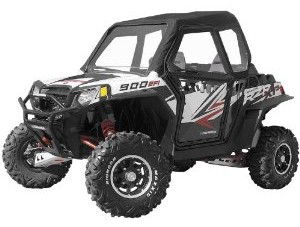Polaris RZR Cab Enclosures

What do classic sports cars have in common with UTVs? Most of them will spend all winter parked up in the garage. When temperatures outside are plummeting, the idea of riding out in an exposed-cab UTV becomes unappealing, but there’s really no need to let your ride sit idle in the cold months. Aftermarket suppliers have a wide array of RZR cab enclosures that will provide protection from the elements, allowing you to enjoy your UTV throughout the year.
The biggest point of discussion surrounding RZR enclosures is whether you need a RZR hard cab or a RZR soft cab. Each of these comes with its own set of benefits and drawbacks, and we will review the major points of each to compare.
Costs
Generally speaking, a RZR hard cab enclosure will be more expensive than a soft cab enclosure.
- Windshields on hard cab units tend to be acrylic or glass, while soft cab units use flexible vinyl, which is less expensive.
- Roofs are typically fiberglass or formed plastics for RZR hard cabs, but vinyl for soft cabs.
- Metal hardware is normally used for mounting hard cabs, but soft cabs can use Velcro or buckle-and-strap attachment points.
- Shipping costs to get the enclosure to you will be higher for a hard cab, as the components weigh more.
Verdict: In the cost contest, soft cabs are the clear winner.
Style
Beauty is in the eye of the beholder. Some UTV owners will prefer the cleaner lines and sharper profiles of RZR hard cabs, while others will prefer the more utilitarian look of the RZR soft cabs. To each his own.
Verdict: Since this is a matter of opinion, we will call this one a draw.
Flexibility
In this discussion, flexibility means the ability to keep up with changing conditions on the fly. For example, if your ride starts in the early morning with very low temperatures, but by midday you’ve got a warm and sunny day, how will your choice of RZR enclosures impact your ride?
- RZR soft cabs have the option of rolling up the front windshield and back windscreen for a “bikini” top approach, and doors are typically easily removed as well.
- RZR hard cabs don’t have this feature, but some will have roll-down windows in the side doors, sliding windows in the back screen, and vented or adjustable front windshields.
- Reconfiguring your RZR from fully enclosed to wide-open is much easier with the soft enclosures.
- Hard cab roofs offer the ability to mount aftermarket accessories, like light bars, directly to the roof. With a soft roof, this is not possible.
- The original installation of a hard cab will take much more time than the installation of a soft cab unit. This is also true for removal of the cab enclosure.
Verdict: When flexibility is important, RZR soft cabs reign supreme.
Protection
Protection can take many forms. It is easy for most RZR cab enclosures to keep you dry, but riders also have to account for wind, cold, penetration from branches, the weight of fallen snow/pooling rain, and rollovers.
- The hard materials used in the roof of RZR hard cabs provide better resistance to snow weight or pooled water weight when parked outside.
- In case of low-hanging branches, hard materials will provide more protection to the rider and more damage resistance to the enclosure.
- Provided that air leak areas are addressed throughout the vehicle, a hard enclosure will be more wind resistant than a soft enclosure.
- RZR hard cabs provide better insulation potential than soft enclosures, maintaining a warmer inside environment.
- In case of a rollover incident, a hard cab enclosure offers better protection from rocks and debris.
- Both soft cabs and hard cabs provide protection from normal elements, like mud or snow or water thrown by the wheels during normal riding.
Verdict: Protection is important, and RZR hard cab enclosures clearly have the advantage.
All-around Utility
Installation of a RZR cab enclosure ensures you get more use out of your UTV, but it can also limit your ride’s suitability for some missions.
- Soft cabs may limit the ability to safely trailer your UTV if your route includes highway travel. At highway speeds, the wind forces on the soft cab enclosure can damage the material to the point of uselessness.
- RZR soft cabs typically have less protection from wind noise and are prone to flapping in strong winds. Recent developments from companies like Seizmik have introduced soft systems that have much tighter fit and adjustability, but there is still no good comparison to a hard enclosure.
- Loose straps from soft tops can be a distraction if not secured as part of the enclosure’s design.
- Where visibility is critical, RZR soft cabs have a major disadvantage. As mentioned above, soft cabs typically use flexible materials like clear vinyl for front, rear, and side windows. Hard cabs use acrylics or glass for crystal-clear viewing.
Verdict: Hard tops keep your UTV ready for all situations, but without the flexibility of soft tops.
In conclusion, where cost is not a factor and conditions are more demanding, a RZR hard cab is a better choice. If flexibility and costs are your driving factors, then a RZR soft cab is your ideal solution. Whichever you choose, stay safe, and enjoy the ride!

